
The Public Plumbing of the Citadal of Mycenae
I have gazed upon the chamber pot of Agamemnon
In Greece you can see latrines and water supplies dating back to the Trojan War. The "Greeks" in that story (and, at least to some degree, actual conflict), were really the Mycenaean people of the Peloponnese peninsula of southern Greece. This was the most powerful kingdom in all of Greece, and there really was a King Agamemnon of Mycenae. Let's find his chamber pot and water supply! Seeing latrines and chamber pots may not be the first thing you think of when you get your Greek travel visa, but it's still pretty interesting. If you want to purchase property in Greece and apply for permanent residency through the Golden Visa Greece program, you will have unlimited time to explore all the historical sites Greece has to offer.
Mycenae, or Μυκήνες in Greek, was first settled by Neolithic people in the 6th millennium BC (although unlike at Skara Brae, we don't seem to have any evidence of their plumbing). It's a hilltop site, pretty barren today, below Mount Agios Ilias (750m) and Mount Zara (600m).
Between about 2100 and 1900 BC, during the Old Bronze Age, Indo-European people crossed Anatolia, moved through Troy, and continued across the Dardanelles to the west and then south through Greece.
The existing settlements in the mainland were primitive, and the new arrivals brought an advanced culture. A number of small kingdoms were established — in addition to the one at Mycenae, there were kingdoms in nearby Tiryns, Pylos, Argos, and Korinthos.
The kingdom of Mycenae became the most powerful by far, leading to the entire civilization of that area being called Mycenaean. For the 400 years from 1600 to 1200 BC, Mycenae was the most powerful kingdom in Greece.
Crete and the ancient settlement of Knossos were also part of the Mycenaean world. The Mycenaean culture also influenced settlements throughout the Aegean Sea, to the north in Epirus and Macedonia, along the coast of Asia Minor and down to the Levant, on the large island of Cyprus in the eastern Mediterranean, and in the Italian peninsula.
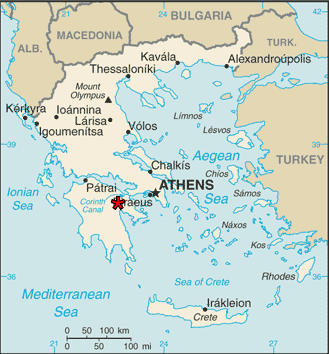
The red star shows the approximate location of Mycenae and Tiryns.
Mycenaean power began to decline around 1200 BC. Its palace was burned around 1100 BC. It's not known if this was caused by an attack from outside Greece, or if it was warfare within the many Mycenaean kingdoms.
It's hard to distinguish history from myth in Mycenae. According to Homer, the city was founded by Perseus, the son of Danae and Zeus. The dynasty of Perseus was eventually overthrown by Pelops, a son of Tanalus.
The real Mycenaean Royal House of Atreus probably was descended from this Pelops, although it's hard to tell what was mythical as opposed to merely mythic. But it seems that some time around the 14th Century BC there really was a King Agamemnon of Mycenae.
Agamemnon (or Άγαμέμνων) is said to have been the son of King Atreus and Queen Aerope of Mycenae. Agamemnon's brother was Menelaus.
There were larger settlements along the coast at the time. As this was the capital of a state dominating much of the eastern Mediterranean, its rulers must have selected this hilltop location for its defensive attributes.
As we will see below, it would have been easier to defend for a short time but it needed a source of water to withstand a siege.
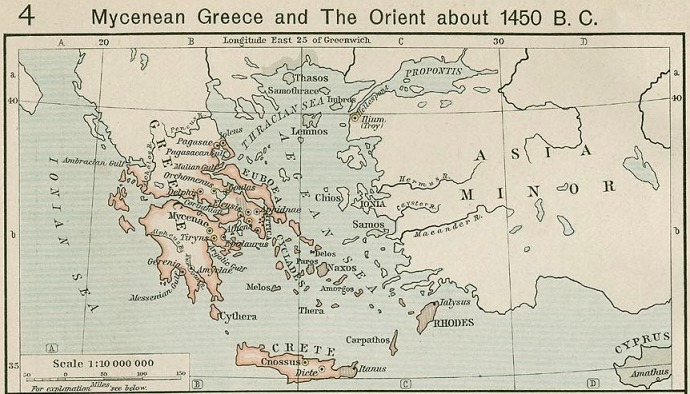
Menelaus' wife Helen was abducted by Paris of Troy and taken back to his city on the northwest coast of Anatolia. Agamemnon then commanded the Achaean forces (what we often mis-label as "Greek" today) in the Trojan War.
When Agamemnon returned home from the Trojan War, his wife, Clytemnestra, had taken a lover, Aegisthus. Agamemnon and his concubine, Cassandra, were killed by Aegisthus, or by Clytemnestra, or by the both of them, depending on which version you read.
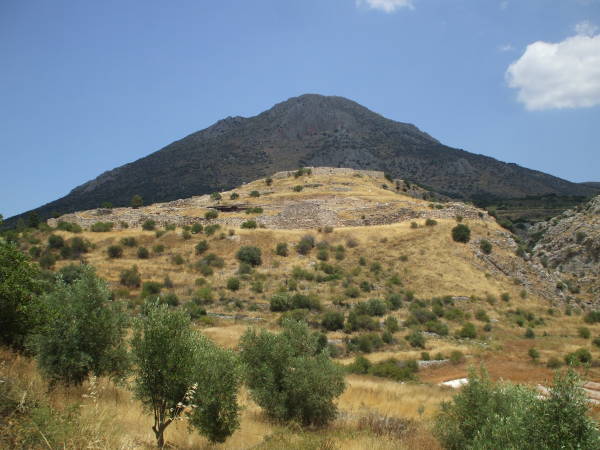
Ancient Mycenae in sunlight with the mountain behind shadowed by cloud.
Skipping ahead to the 1800s AD, Heinrich Schliemann was a history-obsessed businessman turned archaeologist who believed that Homer's Illiad and Odyssey and Virgil's Aenid described real historical events. Few historians and archaeologists thought that these were anything more than myth.
Schliemann got involved in the excavation at the tell or mounded hill of Hissarlık, in Turkey, in 1871.
Archaeology was crude in those days. Believing that Homeric Troy must be the oldest, thus the lowest, level, Schliemann and his workers dug quickly through the layers until they reached fortifications that matched his expectations of Troy. As it later turned out, Hissarlık was Homeric Troy. He did find Troy, but in the process he dug straight through the part he was looking for.
In 1873 Schliemann found a cache of gold objects which he named "Priam's Treasure". He smuggled it out of Turkey, angering the Ottoman Empire to the point that he lost permission to dig further at Troy.
In 1876, he began excavating at Mycenae. Given his record in Turkey, the Greek government made sure they had someone there to watch him.
Schliemann quickly found the Shaft Graves, finding skeletons and regal gold objects. This included what he immediately named the Mask of Agamemnon, and he supposedly sent this cable to the Greek King:
I HAVE GAZED UPON THE FACE OF AGAMEMNON
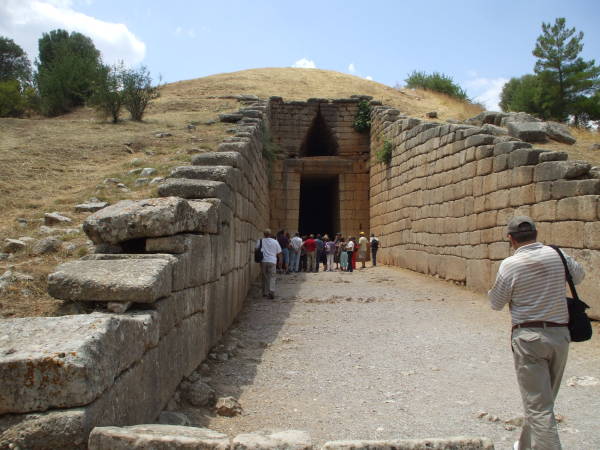
The tholos or "beehive" tomb from the middle 14th century BC, called the "Treasury of Atreus" or the "Tomb of Agamemnon".
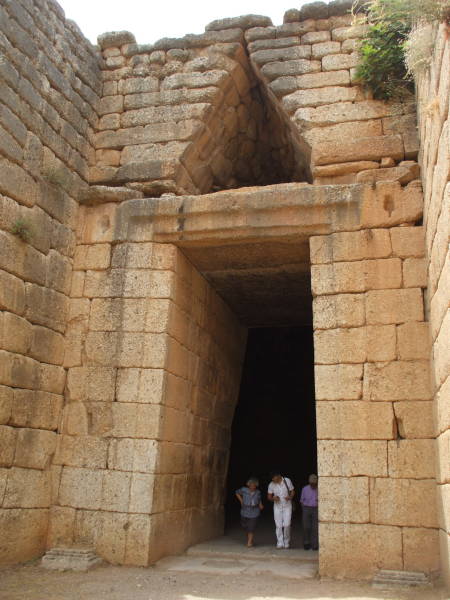
Entrance to the tomb at Mycenae.
The main palace complex was built at the summit of Mycenae's hilltop site. Some remains date back to the Early Helladic period of 3000-2000 BC, but most of what you see here today is from 1300-1200 BC.
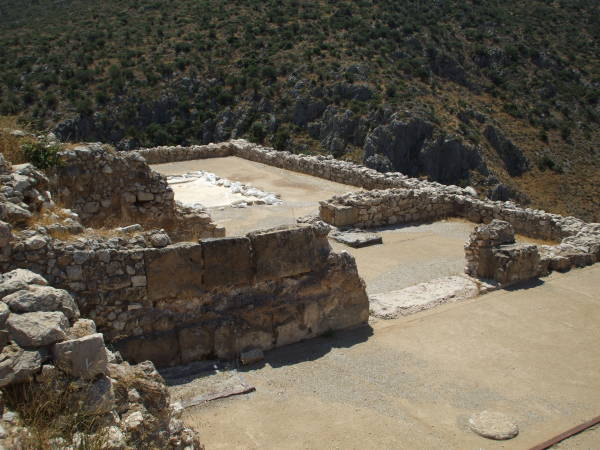
The main palace at Mycenae.
There was a large court and megaron, made up of an entrance portico, a prodromos or antechamber, and the domos or main hall with a large circular hearth at its center.
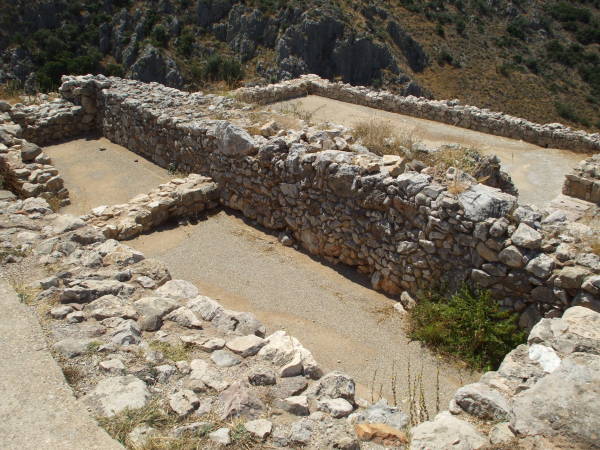
The royal inner chamber in the palace.
The throne was in the middle of the south wall, the wall at the far right in the second picture above. The megaron was the center of political, administrative, military, and economic power at Mycenae.
The inner royal chambers were off the north side of the main hall, opposite the throne. They consisted of a medium sized room and two smaller chambers at the rear. There seems to have been no Royal Latrine, so Agamemnon would have kept his chamber pot here. Chamber pots have been known at least since the 6th century BC in Greece under a variety of names: αμίς, ουράνη, ουρητρίς, σκωραμίς, and χερνίβιον.
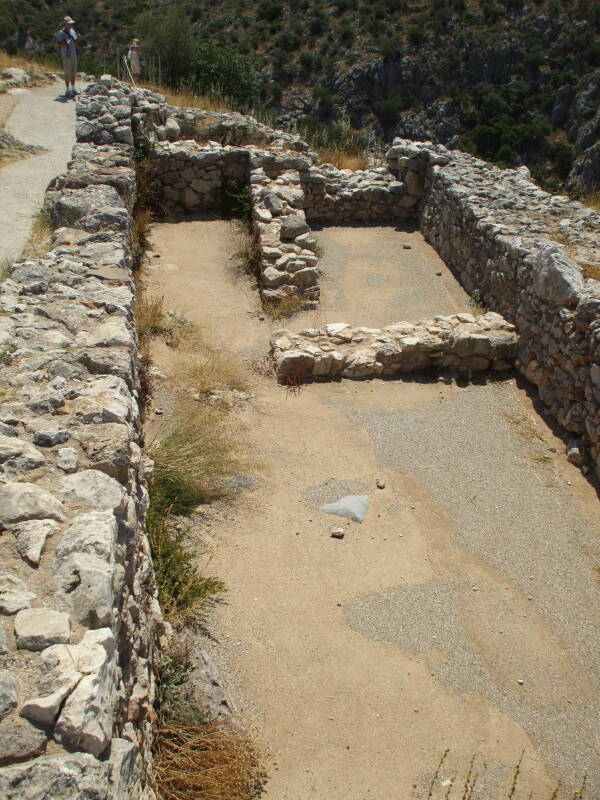
Agamemnon's bed and chamber pot would have been in this
innermost chamber of the main palace.
I HAVE GAZED UPON THE CHAMBER POT
OF AGAMEMNON
The House of Columns was the most important building on the east slope of the Mycenaean citadel. It is beyond the main palace, at the edge of the fortified city where the slope falls away rapidly. It dates to 1250-1200 BC.
I'm not certain, but the structure in the first picture below sure looks like it could be a latrine drain. It is parallel to and just inside the outer wall, and would have drained down the steep hillside outside the defensive wall.
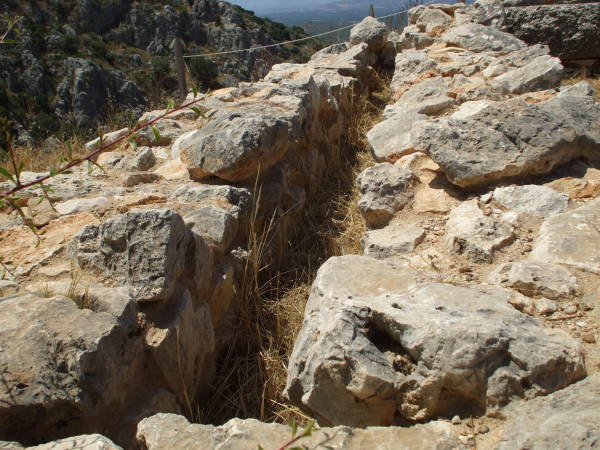
This could be a latrine drain at the House of Columns.
A critical part of defensive siege warfare is the maintenance of the water supply. Water is more critical then food, it's almost always the lack of water that ends a siege. This small pestilential cistern was obviously inadequate!
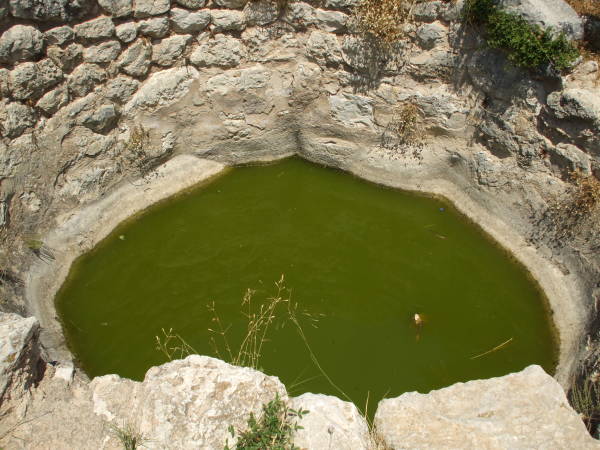
This could really use some disinfectant.
The Mycenaeans had something much better.
Mycenae had a large underground water cistern. The cistern actually laid outside the fortress walls. A corbelled tunnel leads down from inside the fortress, with its entrance near the northeastern corner.
The tunnel passes down through and underneath the fortress walls and continues on down toward the cistern. Eighteen meters down, you reach the large cistern.
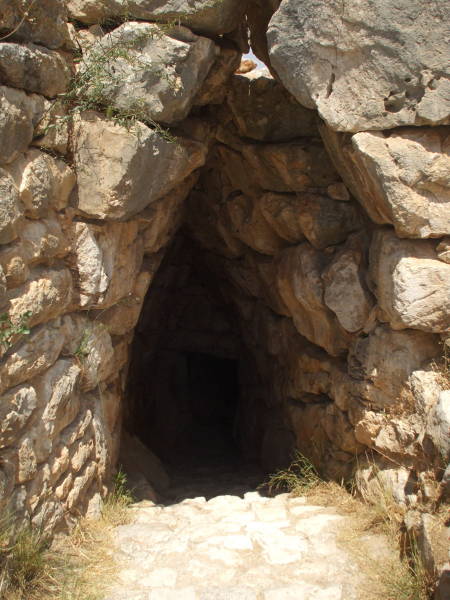
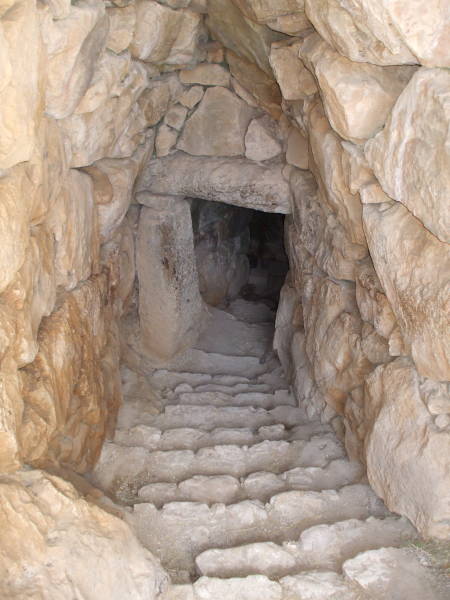
The water was collected from a natural spring well outside the fortress walls, and carried along buried clay conduits to the cistern.
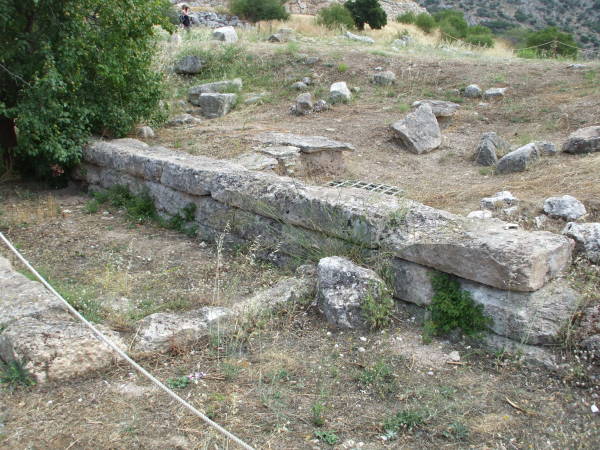
The Perseia Fountain House was named for the natural spring supplying water to the citadel's aquaducts in ancient times. It had a porous stone retaining wall extending a row of water tanks. Steel grates now keep visitors from falling down into those tanks.
The Perseia Fountain House was next to a sacred building dedicated to either the hero Perseus or the goddess Hera. It's relatively recent for Mycenae — what you see here dates to Hellenic times, 300-100 BC.
And yes, if you visit the museum at Mycenae, there is a modern toilet.
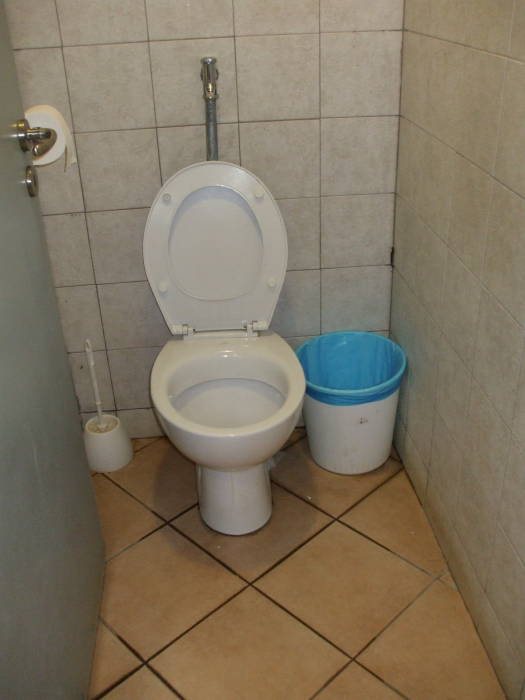
If neither a tersorium nor water were available, the Greeks and Romans used πεσσοι or pessoi, small stones, to clean themselves. The tradition started with the ancient Greeks that three stones should be enough to finish the job. This convention has been very long lived, with a hādīth attributed to Muhammad specifying three stones as the ideal number for anal cleaning. The pessoi were also used in an ancient board game in Greece. Aristophanes wrote a scene involving pessoi in Peace in the 5th century BCE. Here's the Penguin Classics translation:
Arms dealer [displaying a cuirass]: And what, alack, shall I do with this rounded cuirass, a beautiful fit, worth ten minas?
Trygaeus: Well, that one will not make a loss for you, anyway. Give me that at cost price. It will be very convenient to crap in ...
Arms dealer: Stop this impudent mockery of my goods!
Trygaeus [placing the cuirass on the ground like a chamber pot and squatting on it]: Like this, if you put three stones beside it. Is it not clever?
The Greeks would use όστρακα or ostraka, small pieces of broken ceramic goods, to vote to shun or ban their opponents. This is where we get the word ostracize. Some scholars have suggested that the ostraka could be used as pessoi, literally wiping your feces onto the names of hated individuals. The abrasive characteristics of broken ceramic material suggest that long-term used of these as pessoi could have resulted in localized irritation at the least, progressing to skin or mucosal damage or the irritation of external hemorrhoids. For more on toilet use of pessoi and ostraka and the medical implications see the paper "Toilet hygiene in the classical era", Philippe Charlier, Luc Brun, Clarisse Prêtre, and Isabelle Huynh-Charlier, in BMJ (the British Medical Journal) 2012, pages 345-346.
The Public Latrines and Cisterns of Tiryns
Tiryns is another nearby Mycenaean site. It's just 4 kilometers west of Nafplio on the road to Argos.
The Ancient Greek name was Tiryns, Τίρυνς, and that's what we English speakers use. In modern Greek it's Tirintha, Τίρυνθα.
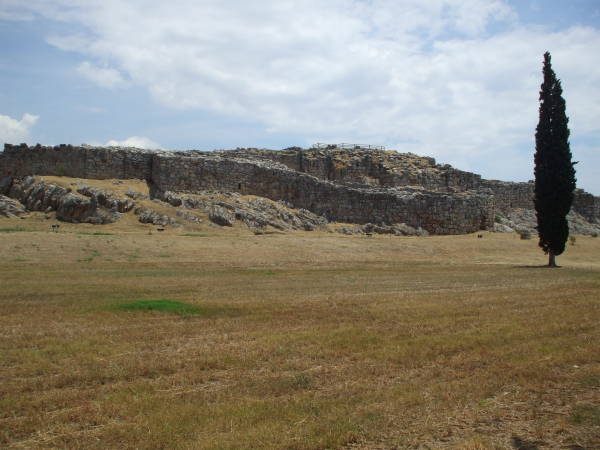
The exterior of Tiryns' walls.
Tiryns dates back to the beginning of the Bronze Age. Like Mycenae, it reached its height in 1400-1200 BC. Homer referred to it as "wall-girt Tiryns" and "mighty-walled Tiryns". The walls are enormous — up to twenty meters thick and made from stones weighing up to 14 tons. The entire complex is 300 meters long and 45 to 100 meters wide. The palace was on an upper level, occupying about half of the citadel.
It's built on a limestone outcropping only about twenty meters high, but its construction and its isolated position made it almost impregnable.
Notice the area marked as 9 in this plan. This area was for military, religious, and economic use, plus housing for the military service members.
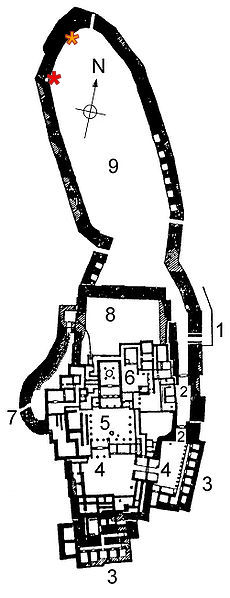
Plan of Tiryns:
1: Entry ramp
2: Entry toward palace
3: East casemates
4: Great propylaia
5: Inner court
6: Megaron
7: Postern
8: Inner courtyard?
* Latrines
* Cisterns
—
Original from Wikimedia Commons
Also notice the orange and red stars. The red star marks the pair of passageways leading to underground cisterns just outside the wall, much like at Mycenae.
The orange star marks what I believe was a public latrine. It is at the far end of the fortress, with a stone trough draining out through a small diameter passage through the thick walls.
The picture below shows the view from close to the number 8 on the plan toward the far end of the citadel.
The entrance ramp, marked as 1 on the plan, was cleverly designed. While it was broad enough for a chariot, an attacker would have been exposed on his right side, where he carried his sword, not his shield. There were multiple heavy doors along the ramp, with plenty of room on top of the broad walls for defenders to gather and hurl weapons or just large rocks on any attacker.
The casemates were used for garrison stores or barracks.
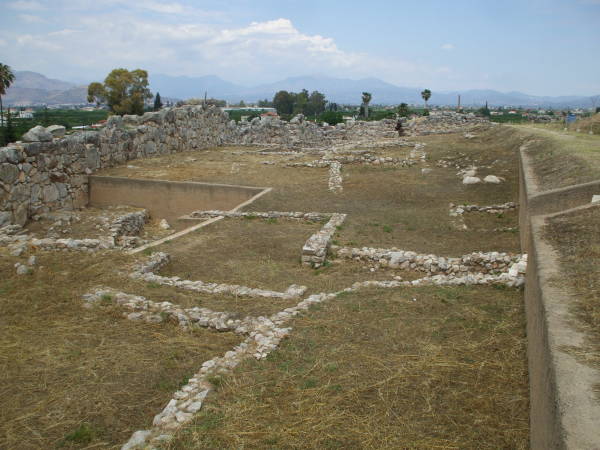
Looking north across Tiryns citadel from the north interior wall dividing the palace from the public area.
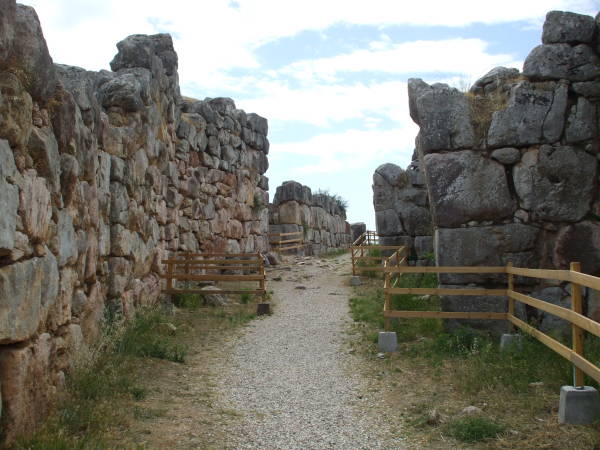
Looking up the entrance ramp. Watch out for arrows coming from your unshielded right!
Visitors passed through the Great Propylia and the Smaller Propylia, a gradual passage through spaces highlighting the significance of what was happening — in this case, moving toward the seat of power. The same design was later used for religious purposes on the Acropolis in Athens.
The Megaron was very similar to the one at Mycenae. There was a porch, a vestibule, a central circular hearth, and the king's throne against the right wall.
The postern gate through the wall looks like a weakness in this overview plan. However, if an attacking force managed to breach the sturdy door that would have been in place, they then would have to ascend a flight of 80 steps. They would then be hit from all sides by the defenders. Even if some made it to the top of the steps, they would find themselves in a sort of trap. And beyond that, another bastion to pass through before getting into the palace.
Here is the southern or left-hand passage leading out through the walls to the underground cisterns.
Some of the exterior wall is missing, exposing parts of these passages to daylight. Back when Tiryns was occupied, the entire passage from inside to the exterior cisterns probably would have been covered.
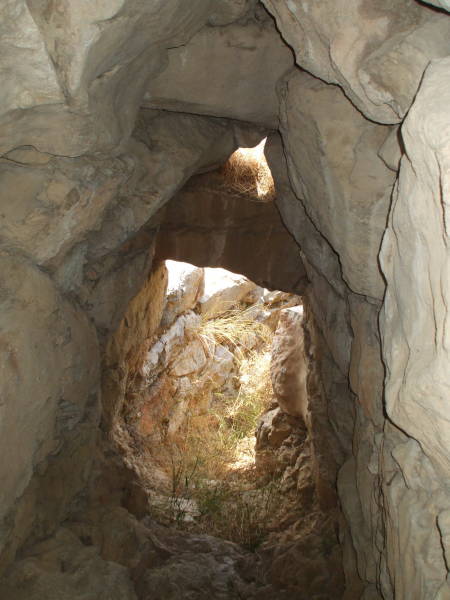
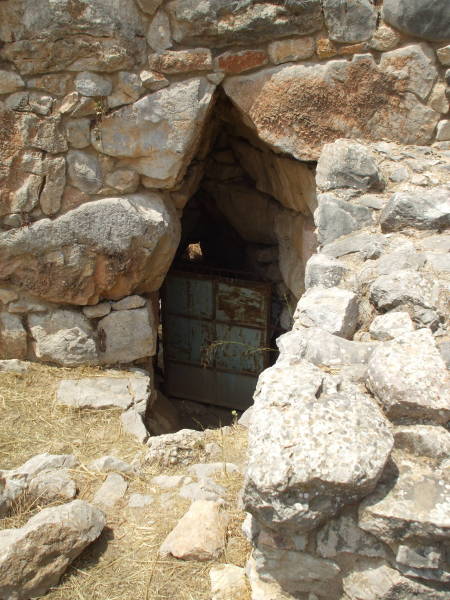
This is the very similar northern or right-hand passage to the cisterns.
These tunnels were only discovered fairly recently. A 1987 Michelin guide describes them as "only recently discovered".
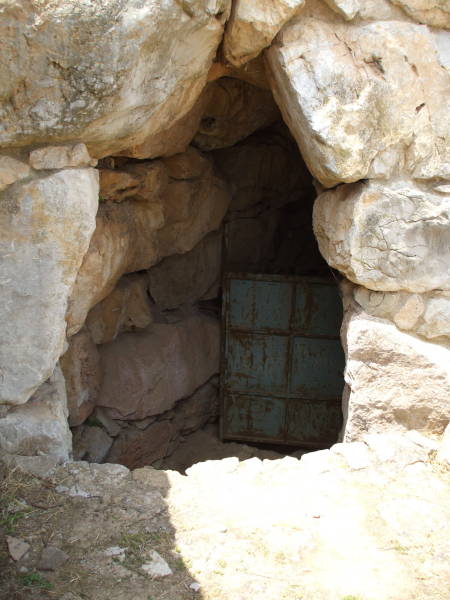
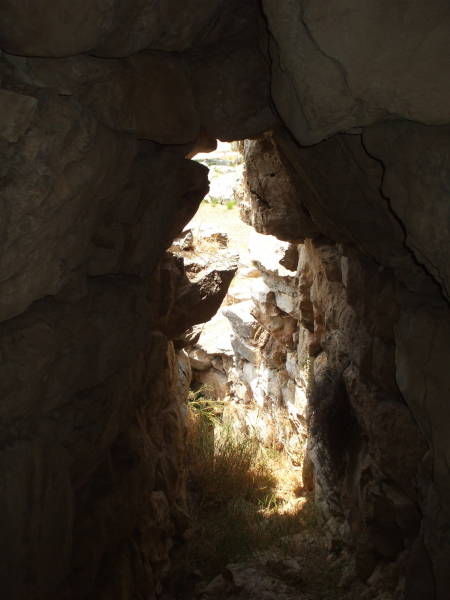
Recent excavations have broken into the top of the tunnels where they exit the walls. That is why you see sunlight shining through these tunnels. They would, of course, have been completely buried back in the day.
Here is what I believe to be a public latrine.
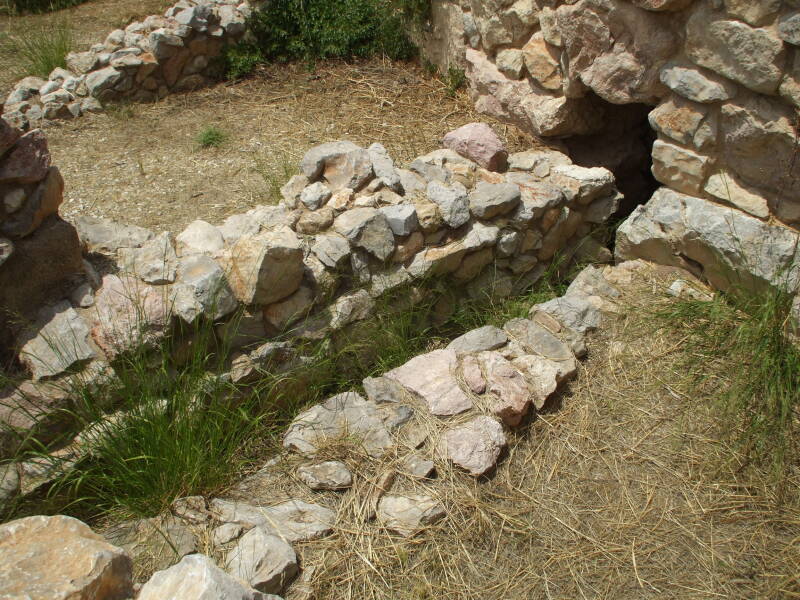
If this wasn't a latrine, then it was some very similar sort of waste drain.
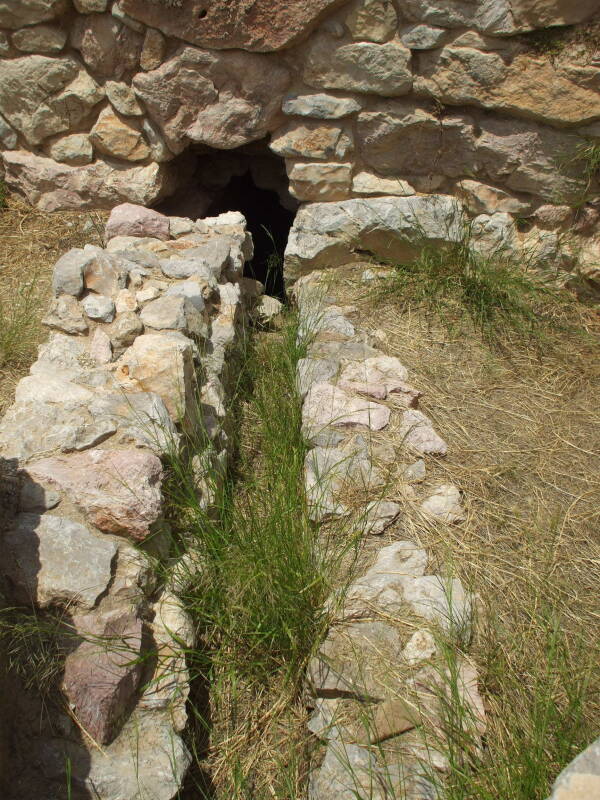
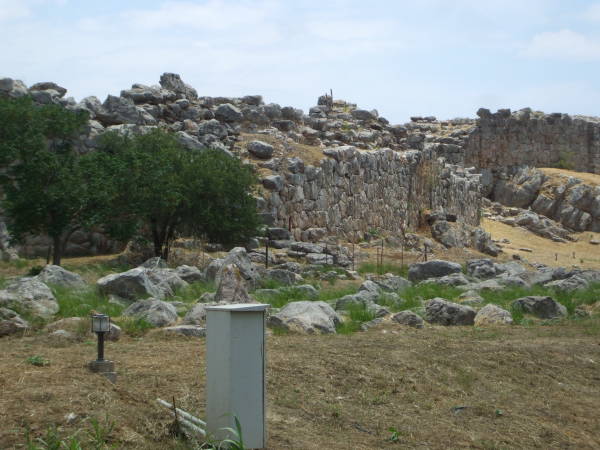
The exterior of the walls immediately outside the latrine and cistern entrances.
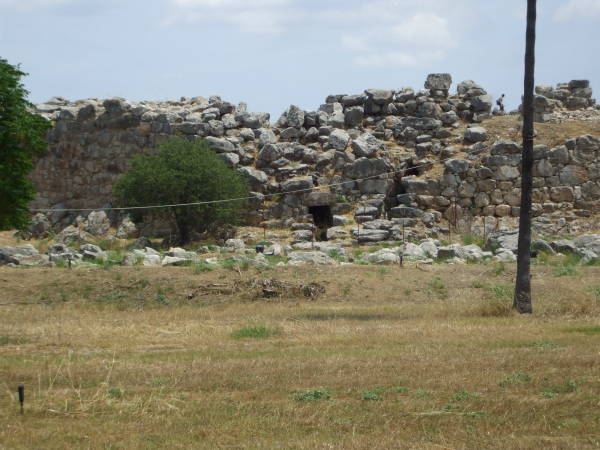
The postern doorway is visible in the exterior wall.

